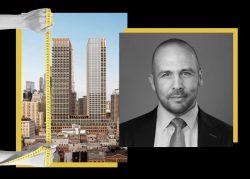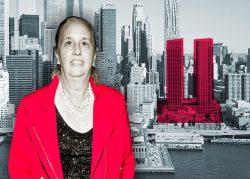UPDATED April 7, 2020, 7:11 a.m.: Howard Hughes Corporation returned to the Landmarks Preservation Commission Tuesday with a shorter, less bulky design for a mixed-use tower at 250 Water Street.
But the reviews from community members and civic leaders were the same as to the developer’s first plan, which was summarily dismissed by the commission as out of scale with the South Street Seaport historic district. Supporters remained supporters and opponents remained opponents, with the exception of the nonprofit New York Landmarks Conservancy, which reversed its position and is now in favor of the plan.
The revised proposal eschews the initial two-tower design atop a podium structure for four interlocking towers set back above a low-rise street wall.
Presented by architect Skidmore, Owings & Merrill, the revision includes a street wall that varies in height and has metalwork on the facade and narrower windows to match other buildings in the district.
But it is still bigger than they are.
The developer has reduced the project’s size by about 27 percent, to 550,000 square feet from 757,000, cut the number of residential units to 270 from 360, and removed 30 of the original 100 affordable housing units in an effort to gain Landmarks’ blessing.
Proponents of the project, including Margaret Chin, the New York City Council member who would determine its fate should it be approved by Landmarks, pleaded for the affordable housing and economic development they claimed the project would provide. They noted that the parking lot on which the development would be built has contributed nothing to the character of the neighborhood for decades.
The same arguments were made in January to no discernible effect on the commission, which focused solely on the project’s appropriateness for the historic district.
Read more


“This is a rare opportunity to do something special and preserve the [South Street] Seaport museum,” said local City Council member Margaret Chin, referring to the $50 million endowment the long-struggling museum would receive from the developer.
“Without the museum there will be no historical district,” she added.
The revised proposal also enjoys the support of Manhattan Borough President Gale Brewer, who has sided against high-rise developments in the past.
Jessica Lappin of the Alliance for Downtown New York said Howard Hughes’s revision was “vastly different” from its first proposal and “integrates community feedback.”
Opponents, however, were unmoved.
Despite Howard Hughes’ reducing the height of the proposed building to 345 feet from 470 and doubling setbacks along Beekman and Water streets, critics blasted what they saw as minor changes.
“The new proposal is more sleight of hand than an attempt to integrate community feedback,” Assembly member Yuh-Line Niou said in a statement, noting that the plans still exceed the 120-foot height limit.
“This developer has never proposed a project within the height limits of the district,” said Niou, who suggested that approval of the design would be unfair to developers who had worked within the neighborhood’s zoning, which prioritizes low-rise street walls.
But those projects did not provide the affordable units and museum subsidy that this one would — and there’s the rub.
Critics reminded the commission that its duty is to consider the appropriateness of the design regardless of any affordable housing or museum funding that the development would unlock.
Joanne Gorman, co-founder of Friends of South Street Seaport, disputed even that.
“The community is being played,” she said. “The sale of city-owned development rights would go to the museum, so the people of New York [and not the developer] will be saving the museum,” Gorman said.
Detractors objected to the transfer of air rights from Pier 17, located within the historic district, to another location in the district, preferring that air rights be transferred out of the neighborhood.
The divide between some community residents and business advocates was drawn in sharp relief during Tuesday’s testimony.
Manhattan Chamber of Commerce CEO Jessica Walker said the pandemic revealed the vulnerability of office-heavy districts, including most of Midtown, emphasizing that residential buildings provide economic stability to surrounding businesses.
Madeleine McGrory, a policy analyst for REBNY, echoed that sentiment, saying housing would help guard the South Street Seaport district from the vicissitudes of tourism, which has been hammered by the pandemic.
Howard Hughes has said if denied approval, it would build a 160-foot-tall structure — 120 feet as-of-right plus an additional 40 feet permitted in a flood zone. That smaller project would not come with any affordable units or museum subsidy. The commission is expected to issue its decision in the coming weeks.
